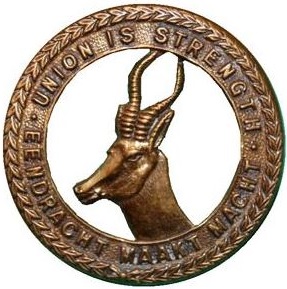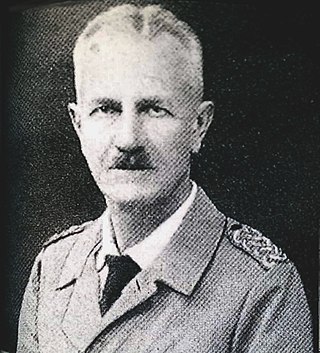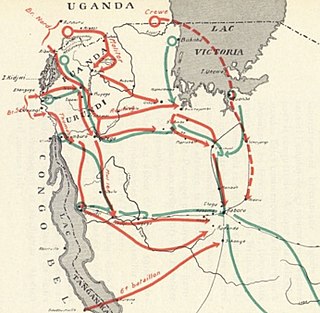
Paul Emil von Lettow-Vorbeck, popularly known as the Lion of Africa, was a general in the Imperial German Army and the commander of its forces in the German East Africa campaign. For four years, with a force of about 14,000, he held in check a much larger force of 300,000 British, Indian, Belgian, and Portuguese troops.

The Battle of Tanga, sometimes also known as the Battle of the Bees, was the unsuccessful attack by the British Indian Expeditionary Force "B" under Major General A. E. Aitken to capture German East Africa during the First World War in concert with the invasion Force "C" near Longido on the slopes of Mount Kilimanjaro. It was the first major event of the war in Eastern Africa and saw the British defeated by a significantly smaller force of German Askaris and colonial volunteers under Lieutenant Colonel Paul von Lettow-Vorbeck. It was the beginning of the East African Campaign of World War I, and is considered one of the greatest victories of the Schutztruppe in Africa. The British retreat enabled the Schutztruppe to salvage modern equipment, medical supplies, tents, blankets, food and a number of Maxim machine guns which allowed them to successfully resist the allies for the rest of the war.

Portugal did not initially form part of the system of alliances involved in World War I and thus remained neutral at the start of the conflict in 1914, but even though Portugal and Germany remained officially at peace for over a year and a half after the outbreak of World War I, there were many hostile engagements between the two countries. Portugal wanted to comply with British requests for aid and protect its colonies in Africa, causing clashes with German troops in the south of Portuguese Angola, which bordered German South-West Africa, in 1914 and 1915.

The 101st Grenadiers was a regiment of the British Indian Army.

The Battle of Jassin was a World War I battle that took place on 18– 19 January 1915 at Jassin on the German East African side of the border with British East Africa between a German Schutztruppe force and British and Indian troops. Jassin had been occupied by the British in order to secure the border between British East Africa and German territory, but was weakly defended by a garrison of four companies of Indian troops, commanded by Colonel Raghbir Singh and numbering a little over 300 men. Colonel Raghbir Singh was killed during the battle.

The African Theatre of the First World War comprises campaigns in North Africa instigated by the German and Ottoman empires, local rebellions against European colonial rule and Allied campaigns against the German colonies of Kamerun, Togoland, German South West Africa, and German East Africa. The campaigns were fought by German Schutztruppe, local resistance movements and forces of the British Empire, France, Italy, Belgium, and Portugal.

The East African campaign in World War I was a series of battles and guerrilla actions, which started in German East Africa (GEA) and spread to portions of Mozambique, Rhodesia, British East Africa, the Uganda, and the Belgian Congo. The campaign all but ended in German East Africa in November 1917 when the Germans entered Mozambique and continued the campaign living off Portuguese supplies.

The South African Overseas Expeditionary Force (SAOEF) was a volunteer military organisation in World War I.

The Battle of Salaita Hill was the first large-scale engagement of the East African Campaign of the First World War to involve British, Indian, Rhodesian, and South African troops. The battle took place on February 12, 1916, as part of the three-pronged offensive into German East Africa launched by General Jan Smuts, who had been given overall command of the Allied forces in the region.
The Battle of Kondoa Irangi was a battle of the East African Campaign of World War I.

The Chambeshi Monument, in the Northern Province of Zambia, also called the Chambeshi Memorial and the Lettow-Vorbeck Memorial, commemorates the final cessation of hostilities of the First World War, three days after the Armistice in Europe.

Kurt Wahle was a Saxon general who travelled to German East Africa in 1914 to visit his son. Being in the colony at the outbreak of World War I, he volunteered to serve under Paul von Lettow-Vorbeck, despite outranking him, and became one of his front commanders. He was involved in the fighting during the East African Campaign until October 1918. During the campaign he was awarded the Iron Cross and commanded the German forces at the Battle of Tabora. He also was recommended for the order Pour le Mérite by von Lettow-Vorbeck, however the recommendation did not reach Germany before the war ended and thus was never approved or awarded.
The Battle of Kisaki was a confrontation between German and South Africa forces near the town of Kisaki, German East Africa, on 7–11 September 1916.

The Battle of Ngomano or Negomano was fought between Germany and Portugal during the East African Campaign of World War I. A force of Germans and Askaris under Paul Emil von Lettow-Vorbeck had recently won a costly victory against the British at the Battle of Mahiwa, in present-day Tanzania and ran very short of food and other supplies. As a consequence, the Germans invaded Portuguese East Africa to the south, both to supply themselves with captured Portuguese materiel and escape superior British forces to the north.

The Battle of Lioma was fought between the German Empire and British Empire during the East African Campaign of World War I. Having successfully evaded the Allies since late 1917, the German Schutztruppe under Paul von Lettow-Vorbeck waged a guerilla campaign in Portuguese East Africa, attacking and raiding settlements as well as forts in the search of supplies while inflicting as much damage as possible on the Allies. All the while, the Schutztruppe was chased by the British King's African Rifles, which finally cornered the Germans at the village of Lioma on 30–31 August 1918. Led by George Giffard, the British forces almost managed to encircle and destroy the Schutztruppe, but in the end the Germans broke out and successfully retreated. Although greatly weakened by the fighting at Lioma, the Schutztruppe was thus able to remain active until the end of the war.

The Tabora Offensive was an Anglo-Belgian offensive into German East Africa, which ended with the Battle of Tabora in the north-west of German East Africa, it was part of the East African Campaign in World War I. The forces of the Belgian Congo crossed the border with German East Africa and captured the port city of Kigoma and the city of Tabora. In August a smaller Lake Force under the command of the South African brigadier general Crewe, launched a parallel attack from Uganda, also aimed at taking Tabora. The completion of the Tabora Offensive not only left much of the Ruanda-Urundi territory under Belgian military occupation but gave the Allies control of the important Tanganjikabahn railway.

Tom von Prince was a German East Africa Company military officer and plantation owner in German East Africa. He most notably, as a captain in the Schutztruppe, led the first action by German forces in East Africa during World War I by seizing Taveta on 15 August 1914, and was then killed in November at the Battle of Tanga.
The Maziua raid was an armed clash between German and Portuguese colonial troops in Mozambique on 24 August 1914 during World War I. Though the two countries were officially at peace, German soldiers carried out a cross-border raid into Portuguese Mozambique for unclear reasons, and destroyed the outpost of Maziua. The Portuguese soldiers killed in the raid were the first Portuguese casualties of World War I.
Major Georg Kraut was an officer of the Imperial German Army during the First World War, a veteran of the Schutztruppe, and the second-in-command of Paul von Lettow-Vorbeck. He was active in German East Africa. He participated in multiple battles, including the Battle of Tanga, the Battle of Salaita Hill, and the Battle of Iringa. Post-war, he joined the Freikorps with Lettow-Vorbeck and helped suppress the Spartacist Revolt.

Erich von Langenn-Steinkeller was a German military officer and official who served as the colonial resident of the Kingdom of Burundi in 1909 and from 1911 to 1916.
















